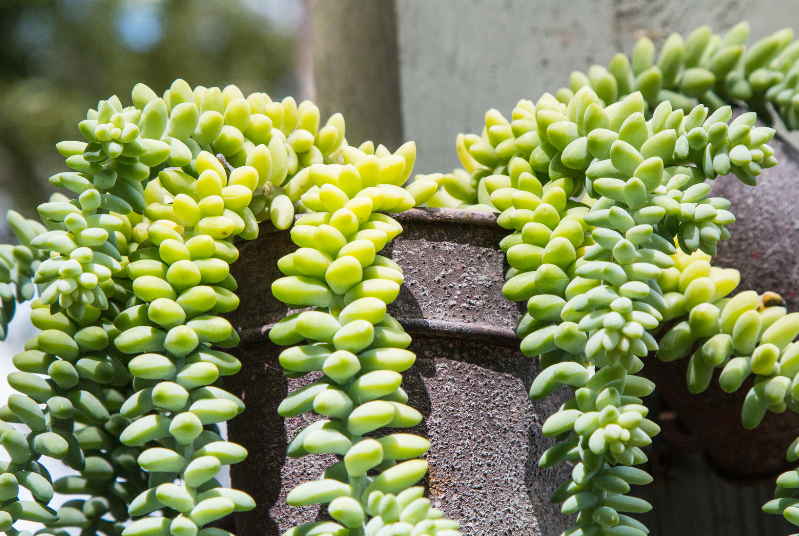
What is the Burro’s Tail Succulent?
Table of Contents
ToggleSedum morganianum, more commonly known as Burro’s Tail, is a trailing succulent native to southern Mexico. Its long, cascading stems are packed with plump, teardrop-shaped leaves that range from green to blue-green. In late summer, it may even reward you with pinkish-red flowers at the tips of its stems, adding a pop of color to its already striking appearance. This plant’s unusual look makes it a popular choice for hanging baskets or as a centerpiece in any collection of succulents.
Why Grow a Burro’s Tail?
So why should you grow a Burro’s Tail? Its striking appearance makes it a conversation piece, and it’s also perfect for both seasoned gardeners and beginners alike. This plant doesn’t demand constant attention but still adds a touch of elegance to any indoor or outdoor space. Plus, with the proper care, it can live for years and grow up to four feet long!
Caring for Your Burro’s Tail Succulent
Light Requirements
Sunlight is crucial for the health of your Burro’s Tail. Ideally, you want to provide it with bright, indirect light or full sun. Placing it near a south- or east-facing window is ideal if grown indoors. Outdoors, acclimate it to direct sunlight slowly to avoid sunburn on its delicate leaves. Too much intense, direct sun can cause its leaves to fall off.
Temperature and Humidity Needs
The Burro’s Tail thrives in warm temperatures ranging between 65°F and 80°F. It’s essential to keep the plant in a location with good airflow and low humidity, as succulents prefer dry environments. Extreme cold or frost can damage or kill the plant, so it’s best to bring it indoors during winter if you live in a cooler climate.
Best Soil and Potting Practices
Choosing the Right Soil
One of the most critical factors for keeping your Burro’s Tail healthy is using the right soil. Like other succulents, it requires well-draining soil to prevent root rot. You can use a cactus mix or make your blend by mixing regular potting soil with perlite, pumice, or coarse sand. This ensures water drains quickly, preventing overwatering.
Picking the Right Pot
Hanging baskets are a popular choice for Burro’s Tail because of its trailing nature. However, the type of pot you choose matters. Make sure to use a container with drainage holes to allow excess water to escape. Since this plant grows relatively slowly, you’ll only need to repot every two to three years—or if you notice it has outgrown its container.
Watering Your Burro’s Tail
When to Water
Succulents, including Burro’s Tail, don’t need frequent watering. In fact, overwatering is one of the most common problems that can lead to root rot. A good rule of thumb is to water deeply but infrequently. Wait until the soil is completely dry before giving it a good soak. During the winter months, you can reduce watering even further since the plant goes into a dormant state.
Fertilizing Your Succulent
Although your Burro’s Tail doesn’t require much fertilizer, you can boost it by applying a balanced houseplant fertilizer, half-diluted, once a month during the growing season (spring and summer). Avoid feeding it during the fall and winter when the plant isn’t growing.
Common Problems with Burro’s Tail Succulent
Pests to Watch Out For
Burro’s Tail can fall victim to pests like mealybugs and aphids like many indoor plants. These tiny insects can hide between the leaves, sucking the plant’s juices and causing damage. To deal with these pests, wipe the plant down with a cloth dipped in rubbing alcohol or use an insecticidal soap spray.
Overwatering and Root Rot
Overwatering is the Burro’s Tail’s worst enemy. Signs of overwatering include yellowing leaves, mushy stems, and, in severe cases, root rot. If you suspect root rot, repotting the plant in fresh, dry soil and reducing watering is best.
How to Propagate Burro’s Tail Succulents
Propagating with Stem Cuttings
If you want more Burro’s Tail plants (and who wouldn’t?), the easiest way is to propagate through stem cuttings. Cut a healthy stem, allow it to callus over for a few days, and plant it in well-draining soil. Water sparingly until the new plant starts showing signs of growth.
Leaf Propagation
You can also propagate Burro’s Tail by using individual leaves. Remove a leaf carefully from the stem and let it dry out for a day or two. Then, place the leaf on top of some moist soil and wait. Tiny roots will start to appear in a few weeks, and new growth will follow.
Seasonal Care Tips for Your Burro’s Tail
Outdoor Summer Care
During the summer, your Burro’s Tail can thrive outdoors as long as it’s kept out of direct afternoon sunlight. Move it outside gradually so it can adjust to the brighter light, and make sure it’s in a spot with good airflow.
Winter Care
In winter, your Burro’s Tail needs a little extra attention. Keep it in a cooler spot indoors, but avoid temperatures that drop below 50°F. Cut back on watering since the plant’s growth slows down in cooler weather.
Final Thoughts
The Burro’s Tail succulent is a stunning, low-maintenance plant that rewards you with its unique cascading look. Whether you’re an experienced gardener or just getting started, it’s a great addition to your collection.
You’ll enjoy this beauty for many years with the proper care, attention, and occasional propagation. Ready to give it a try? Grab a Burro’s Tail, and let your succulent journey begin!


























